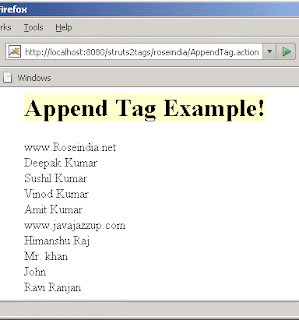In this section, we are going to describe the append tag. The append tag is a generic tag that is used to merge multiple iterators into one iterator. Append Iterator Tag is used to append iterators to form an appended iterator through which the entries goes from one iterator to another after each respective iterator is exhausted of entries.
Add the following code snippet into the struts.xml file.
struts.xml:
Create two lists in the action class and populate them with various items as shown in the "AppendTag" class.
AppendTag.java
Now create a jsp page using
AppendTag.jsp
Output of the Append Tag Example:
Add the following code snippet into the struts.xml file.
struts.xml:
<action name="AppendTag" class="net.struts.AppendTag"> <result>/pages/genericTags/AppendTag.jsp</result> </action>
Create two lists in the action class and populate them with various items as shown in the "AppendTag" class.
AppendTag.java
package net.stuts2-example;
import com.opensymphony.xwork2.ActionSupport;
import java.util.*;
public class AppendTag extends ActionSupport{
private List myList;
private List myList1;
public String execute()throws Exception{
myList = new ArrayList();
myList.add("www.struts.net");
myList.add("Deepak Kumar");
myList.add("Sushil Kumar");
myList.add("Vinod Kumar");
myList.add("Amit Kumar");
myList1 = new ArrayList();
myList1.add("www.javajazzup.com");
myList1.add("Himanshu Raj");
myList1.add("Mr. khan");
myList1.add("John");
myList1.add("Ravi Ranjan");
return SUCCESS;
}
public List getMyList(){
return myList;
}
public List getMyList1(){
return myList1;
}
}
Now create a jsp page using
AppendTag.jsp
<%@ taglib prefix="s" uri="/struts-tags" %>
<html>
<head>
<title> Append Tag Example!</title>
</head>
<body>
<h1><span style="background-color: #FFFFcc"> Append Tag Example! </span></h1>
<s:append id="myAppendList">
<s:param value="%{myList}" />
<s:param value="%{myList1}" />
</s:append>
<s:iterator value="%{#myAppendList}">
<s:property /><br>
</s:iterator>
</body>
</html>
Output of the Append Tag Example:

Comments
Post a Comment